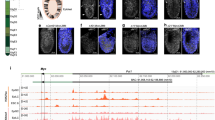Summary
We have isolated more than 50 dominant suppressors and 3 dominant enhancers of position effect variegation in Drosophila melanogaster. To our surprise, genetic mapping studies revealed that the Su(var) mutations are not randomly dispersed throughout the genome of this organism. Rather they fall into very discrete clusters. Moreover, all of the induced Su(var) mutations which map to a major second chromosome cluster are recessive lethal, whereas all of those which map within any of several third chromosome clusters are viable. Complementation analysis involving Su(var) mutations located within the 2L cluster suggests that several different loci occupy this site. Thus, these clusters may represent groupings of functionally related but distinct Su(var) loci.
A subset of the suppressors were examined for their effects on several different variegating rearrangements. The results suggest that the suppressing ability of the mutants is general. Interestingly, the effects of the suppressors in males appears to be highly dependent upon the presence of the Y chromosome. Finally, examination of the Su(var) mutants at different developmental temperatures indicated that at least one of them is temperature-sensitive. These findings are discussed with respect to the potential for genetic and functional dissection of loci which encolde chromosomal components.
Similar content being viewed by others
References
Appels R, Hilliker AJ (1982) The cytogenetic boundaries of the rDNA region within heterochromation of the X chromosome of Drosophila melanogaster and their relation to male meiotic pairing sites. Genet Res 39:149–156
Baker WK (1968) Position-effect variegation. Adv Genet 14:133–169
Demerec M, Slizynska H (1937) Mottled white 258-18 of Drosophila melanogaster. Genetics 22:641–649
Dubinin NO, Sidorov BN (1935) The position effect of the hairy gene. Biol Zh Mosk 4:555–568
Gowen JW, Gay EH (1933) Effect of temperature on eversporting eye colour in Drosophila melanogaster. Science 77:312
Gowen JW, Gay EH (1934) Chromosome constitution and behavior in ever-sporting and mottling in Drosophila melanogaster. Genetics 19:189–208
Hartmann-Goldstein IJ (1967) On the relationship between heterochromatization and variegation in Drosophila, with special reference to temperature-sensitive periods. Genet Res 10:143–159
Henikoff S (1979a) Does position-effect variegation in Drosophila result from somatic gene loss? In: Axel R, Maniatis T., Fox CF (eds) Eukaryotic gene regulation. Academic Press, New York, pp 123–132
Henikoff S (1979b) Position-effects and variegation enhancers in an autosomal region of Drosophila melanogaster. Genetics 93:105–115
Henikoff S (1981) Position-effect variegation and chromosome structure of a heat shock puff in Drosophila. Chromosoma 83:381–393
Hsieh T, Brutlag D (1979) A protein that preferentially binds Drosophila satellite DNA. Proc Natl Acad Sci USA 76:726–730
Judd BH (1955) Direct proof of a variegated-type position-effect at the white locus in Drosophila melanogaster. Genetics 40:739–744
Levinger L, Varshavsky A (1982a) Selective arrangement of ubiquitinated and D1 protein-containing nucleosomes within the Drosophila genome. Cell 28:375–385
Levinger L, Varshavsky A (1982b) Protein D1 preferentially binds A+T-rich DNA in vitro and is a component of Drosophila melanogaster nucleosomes containing A+T-rich satellite DNA. Proc Natl Acad Sci USA 79:7152–7156
Lewis EB (1950) The phenomenon of position effect. Adv Genet 3:73–115
Lewis EB, Bacher F (1968) Method of feeding ehtyl methanesulfonate (EMS) to Drosophila males. Drosophila Inf Serv 43:193
Lindsley DL, Grell EH (1968) Genetic variations of Drosophila melanogaster. Carnegie Inst Wash Publ No 627
Moore GD, Procunier JD, Cross DP, Grigliatti TA (1979) Histone gene deficiencies and position-effect variegation in Drosophila. Nature 282:312–314
Moore GD, Sinclair DA, Grigliatti TA (1983) Histone gene multiplicity and position-effect variegation in Drosophila melanogaster. Genetics, in press
Mottus R, Reeves R, Grigliatti TA (1980) Butyrate suppression of position-effect variegation in Drosophila melanogaster. Mol Gen Genet 178:465–469
Mottus RC, Moore GD, Sinclair DAR, Grigliatti TA (1982) A genetic and biochemical analysis of position-effect variegation in Drosophila melanogaster. Can J Genet Cytol 24:633–634
Nix CE (1973) Suppression of transcription of the ribosomal RNA cistrons of Drosophila melanogaster. in a structurally rearranged chromosome. Biochem Genet 10:1–12
Panshin IB (1935) New evidence for the position-effect hypothesis. CR (Dokl) Acad Sci URSS 9(4):85–88
Prokofyeva-Belgovskaya AA (1947) Heterochromatization as a change of chromosome cycle. J Genet 48:80–98
Reuter G, Werner W, Hoffman HJ (1982) Mutants affecting position-effect heterochromatinization in Drosophila melanogaster. Chromosoma 85:539–551
Reuter G, Wolff I (1981) Isolation of dominant suppressor mutations for position-effect variegation in Drosophila melanogaster. Mol Gen Genet 182:516–519
Rodriguez-Alfageme C, Rudkin GT, Cohen LH (1980) Isolation, properties and cellular distribution of D1, a chromosomal protein of Drosophila. Chromosoma 78:1–31
Schultz J (1950) Interrelations of factors affecting heterochromatin-induced variegation in Drosophila. Genetics 35:134
Schultz J (1956) The relation of heterochromatic chromosome regions to the nucleic acids of the cell. Cold Spring Harbor Symp Quant Biol 21:307–327
Sinclair DA, Moore GD, Grigliatti TA (1980) Isolation and preliminary characterization of putative histone gene deficiencies in Drosophila melanogaster. Genetics 94:596
Spofford JB (1967) Single locus modification of position-effect variegation in Drosophila melanogaster. I. White variegation. Genetics 57:751–766
Spofford JB (1969) Single-locus modification of position-effect variegation in Drosophila melanogaster. II. Region 3C loci. Genetics 62:555–571
Spofford JB (1976) Position effect variegation in Drosophila. In: Ashburner M, Novitski E (eds) The genetics and biology of Drosophila, vol 1C. Academic Press, New York, pp 955–1018
Tattersall PJ (1981) Induced recombination in the proximal region of chromosome 2 in females of Drosophila melanogaster. MSc Thesis, University of British Columbia
Zuckerkandl E (1974) Recherches sur les propriétés et l'activité biologique de la chromatine. Biochimie 56:937–954
Author information
Authors and Affiliations
Additional information
Communicated by M.M. Green
Rights and permissions
About this article
Cite this article
Sinclair, D.A.R., Mottus, R.C. & Grigliatti, T.A. Genes which suppress position-effect variegation in Drosophila melanogaster are clustered. Mol Gen Genet 191, 326–333 (1983). https://doi.org/10.1007/BF00334834
Received:
Issue Date:
DOI: https://doi.org/10.1007/BF00334834




